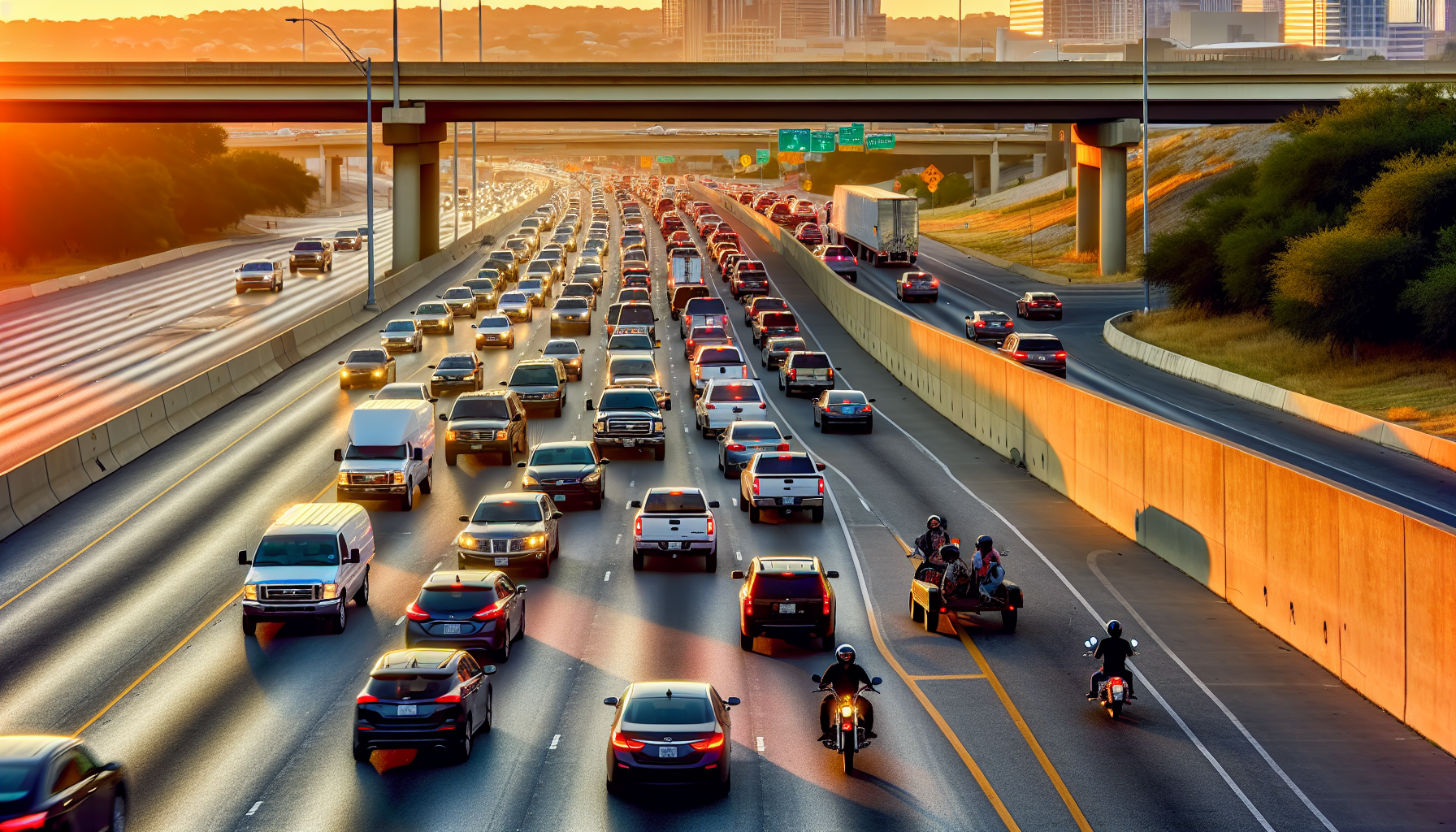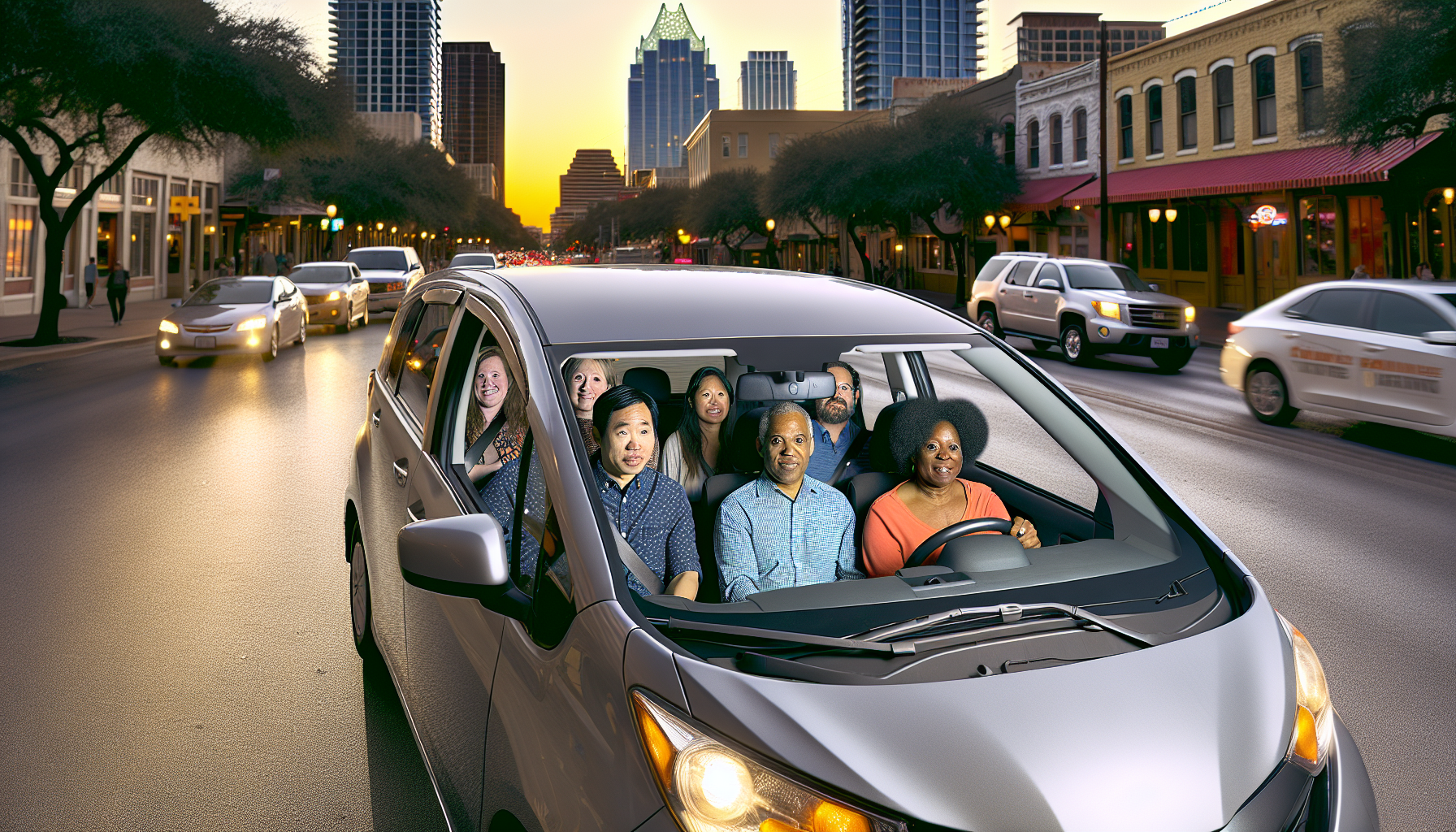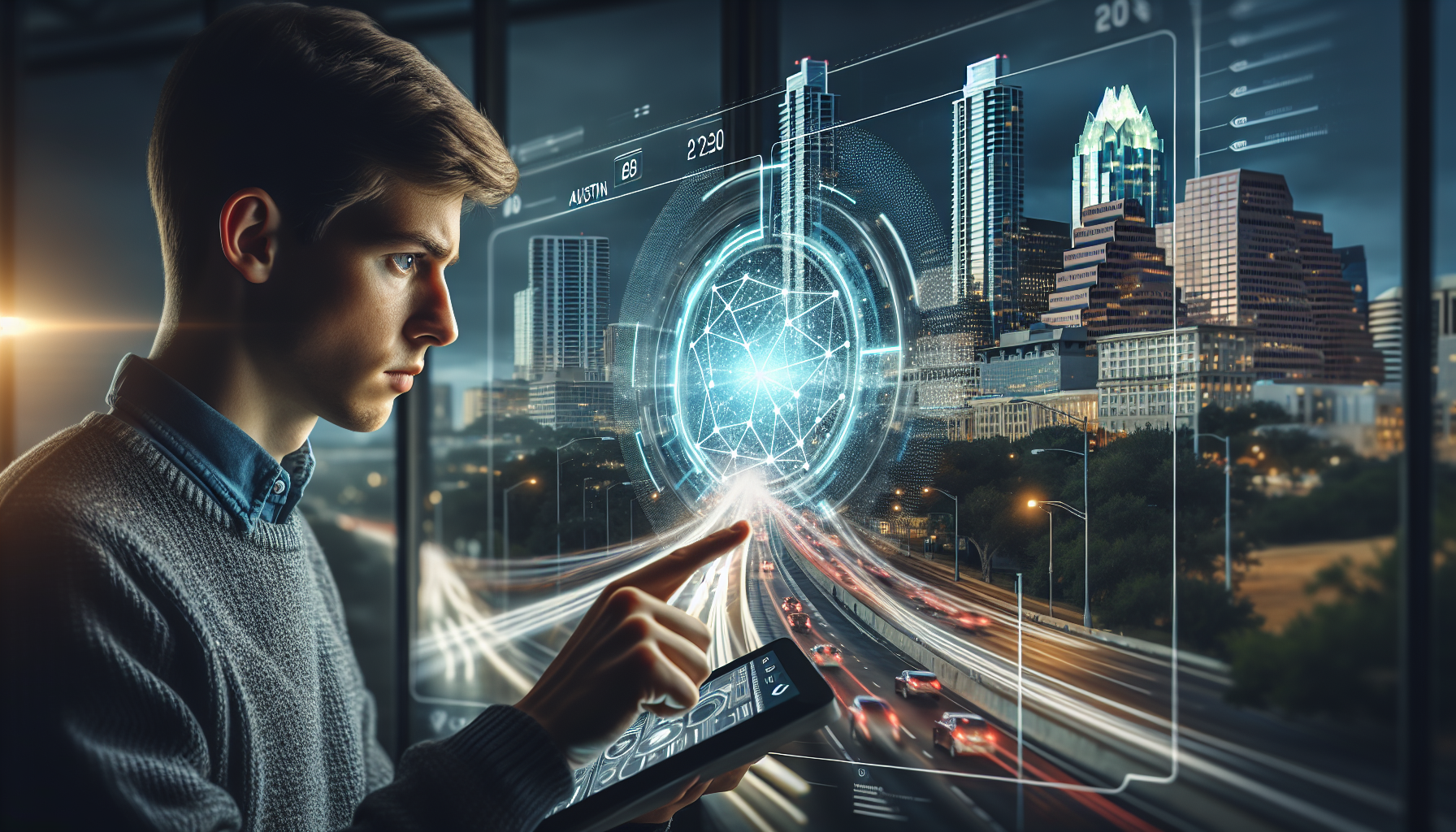Navigating Austin Rush Hour: Tips to Beat the Traffic Gridlock

Feb 19, 2024
Austin, Texas, is known for its vibrant culture, booming economy, and, unfortunately, its notorious traffic congestion. But why is Austin’s traffic so bad, and what can you do to navigate through it efficiently during Austin rush hour? This blog post will unpack the factors contributing to the city’s traffic woes and offer practical tips to save time and reduce frustration during rush hour.
Key Takeaways
- Austin’s rapid population growth, infrastructure limitations, and prevalent solo driving habits have significantly worsened the city’s traffic congestion, with the average resident losing 32 hours a year to traffic.
- To navigate peak traffic times, which typically occur between 7 a.m. and 8 a.m. and then between 3 p.m. and 5 p.m., Austin commuters can leverage alternative routes and local roads, adjust their schedules, or use CapMetro public transportation and carpooling options.
- Staying informed with traffic apps such as Google Maps, and Waze, and local applications like the Transit App can provide real-time traffic updates and suggest alternative routes to help commuters manage travel during rush hours and around unpredictable delays due to weather and special events.
Understanding Austin’s Rush Hour Traffic

Austin’s traffic, commonly referred to as Austin congestion, is among the worst cities in America. It’s similar to places like New York and Los Angeles. What accounts for this situation? It is attributed to the rapid population growth of the city, along with infrastructure limitations and how people drive. This bustling business scene coupled with an influx of inhabitants, has resulted in a notable increase in traffic woes experienced by citizens residing within Austin’s boundaries, they are now squandering 32 hours every year due to congested roads!
Over time since 2012 when Austin ranked as the fourth most trafficked metropolis nationwide, their current spot at 21 points out more cars circling through its streets compared to before. So why have these conditions happened? Let us investigate what causes can be closely linked to such developments impacting all residents equally who need suitable solutions soon enough if movement around will remain viable long-term future prospects across town wise everyone still enjoys easily via commute daily without excess delays common mostly noticed nowadays routinely upon main highways heading key destinations habitual journeys locals usually take almost regularly lately: gridlock basically everywhere already local close proximity deep nearby neighborhoods.
Population Growth
Austin boasts a bustling economy and many cultural attractions that have been largely responsible for the population growth of approximately 962,000 people each year. This rate is much higher than other cities in Texas, thus making Austin an attractive destination with more residents moving into the city every day. The influx has significantly impacted traffic on major thoroughfares such as The Domain, Mueller Circle C, and suburban areas, which all experience immense crowding due to the increased congestion caused by this rapid expansion in population size.
Infrastructure Limitations
With Austin’s growing population, traffic congestion is a major problem, especially during peak hours. To improve the situation in downtown Austin and elsewhere in the city, projects such as the I-35 expansion are being pursued by the local government. Insufficient funding combined with environmental constraints pose challenges to these plans. The demands of preserving what makes this metropolis unique while effectively managing its growth make it difficult for city planners to tackle rush hour gridlock caused by only one interstate passing through town. Ultimately, they hope that improvements in infrastructure will help reduce all types of delays, both morning and evening, resulting from increased numbers of vehicles using urban roads.
Driving Habits
The traffic in Austin is heavily affected by the driving habits of its inhabitants. A striking 66% of commuters elect to drive alone, with 43% commuting exclusively via car—both playing a big part in causing congestion on the roads. To address this issue and prevent buildups during rush hour times, authorities are advocating transportation demand management tactics such as public transportation usage, pedestrian walking paths, and carpooling schemes that would help reduce clogged-up streets across Austin’s suburbs. This could be an effective way for residents to lower their contribution to traffic within the city itself.
Peak Traffic Times in Austin

Rush hour in Austin can be especially difficult on Wednesdays, with an average of 20 minutes and 50 seconds to travel 10 kilometers. Knowing peak traffic times is a key part of making your commute more efficient. For example, between 7-8 am and 3-5 p.m., the city experiences the most congestion – typically downtown near I-35 or MoPac as well as southwest at both highways (183 & 290). With this information, you’ll have better chances of navigating these peak periods without encountering unnecessary delays.
Alternative Routes and Local Roads
Traffic congestion is a major problem with Austin’s city layout. To address this issue, the City of Austin has been using transportation demand management strategies to promote alternative routes and local roads during peak hours. These include I-35, MoPac near downtown, Southwest near MoPac/Hwy 290, and Northwest on Hwy 183, which experience less traffic at such times compared to other areas. These strategies aim at shifting trips off-peak time as well as encouraging teleworking, carpooling, vanpooling public transit walking, or biking when possible for better commute convenience overall.
Public Transportation and Carpooling Options

During Austin’s rush hour, many commuters choose to make use of public transportation and carpooling options. CapMetro offers several services in the city including frequent stop service with routes across town as well as on-demand Pickup rideshare vehicles and 20 Park & Ride locations or transit hubs. 34% of those commuting opt for other methods than solely driving alone, a strong indication that there is high usage of carpool alternatives. Let us take a deeper dive into these choices available to Austinite drivers.
CapMetro Services
CapMetro offers a range of services and routes that allow users to plan their trips efficiently. Their options include bus routes, Park & Ride facilities, and various fare/pass choices such as North Lamar/South Congress (1), Rosewood-CESAR CHAVEZ (2), Burnet-Manchaca (3), or 7th Street(4). CapMetro App functions like real-time trip updates, pass purchases, and notifications about modifications in route plans to help travelers navigate public transportation with ease even during peak traffic times. The organization also provides educational programs to reduce dependence on personal vehicles at high levels of traffic congestion.
Carpooling and Ridesharing

During peak rush hour traffic in Austin, carpooling and ridesharing services are efficient options for commuters. Apps like MetroRideShare, myCommuteSolutions, Earth Rides, and Wridz connect drivers with passengers who need to get to the same destination. SendaRide HopSkipDrive Kidcaboo! Wingz provides other commuting alternatives that can be useful during this time of day. The prices vary per service. Lime scooters charge $1 plus 42 cents a minute, while vanpool fares depend on vehicle type among other variables such as distance traveled. By taking advantage of these apps, you help reduce congestion and save money!
Adjusting Your Schedule
In Austin, the traditional work hours are 8 am to 5 pm and they correspond with periods of peak traffic congestion typically occurring in the mornings between 6-9 am and evenings from 4-7 pm. To avoid long commute times, companies offer flexible schedules so staff can arrange their working hours around off-time travel. Living near your workplace is another solution as well as a remote option being available for many positions. Suggestions such as leaving a bit earlier than normal could be beneficial when trying to escape gridlock during these infamous rush hour intervals. Here are some tips that may help Optimize this strategy:
Preparing for Unpredictable Traffic Conditions
It is essential to be prepared for Austin’s unpredictable traffic conditions and avoid getting taken off guard by any increased levels of vehicles on the road. Unexpected weather changes like heavy rain, fog, or snow can lead to dangerous driving conditions that create congestion in the city. On top of this, special events held around town, including festivals, live music shows, and big occasions monitored by the Austin Transportation Department, could boost numbers in terms of cars circulating.
Road closures due to environmental matters (harsh weather), festivities being celebrated, or construction processes might also seriously affect how one gets from A to B within the Austin area. It’s paramount that people stay informed regarding these possible interferences with their daily commutes so they’re able to successfully plan ahead before leaving home each morning.
Weather-Related Delays
Traffic in Austin is greatly impacted by the weather. Poor conditions like cold temperatures, ice, snow, and sleet may cause delays on roads, while windy or foggy days could even lead to closures. Drivers should take caution when faced with a severe climate. Decreasing speed and keeping a greater distance from other vehicles are some ways of ensuring safety during such periods of inclement weather. Rain can prove treacherous too due to decreased visibility as well as causing hydroplaning, which increases risk levels for drivers. – if circumstances become dangerous, it’s best that you pull off safely until they improve again.
Special Events and Road Closures
In the spring, Austin experiences many special events that can lead to major traffic delays during rush hour. Many drivers opt for toll roads as an alternative route due to congestion near certain closures such as low water crossings and roadways like Pleasant Valley Road or Riverside Drive. The most intense levels of gridlock start around 3 p.m., peaking at 5 p.m.
Staying Informed with Traffic Apps and Updates

Staying up-to-date with traffic has become simpler in the digital era. Apps like Google Maps and Waze offer commuters real-time updates on road conditions, alternate routes to bypass busy roads during rush hour, voice guidance along their journey, as well as accurate drive time estimates every day. Some applications even provide new information within 30 seconds of their arrival.
Austin-specific apps for locals have also been created – The Transit App works alongside Capital Metro to give directions that involve public transportation around Austin, while Metropia Inc. provides DUO, which encourages drivers and passengers living there by incentivizing them to!
Summary
Rush hour traffic in Austin can be tricky. With knowledge of the elements that contribute and the preparation of practical strategies, it doesn’t have to feel so intimidating. Population growth as well as infrastructure limitations combined with certain driving behaviors lead to rush hours being more congested than usual, typically during morning or evening peak times, especially around highways and main roads. One way to battle this is by looking into alternative routes like local streets, taking public transportation services, riding together with co-workers for carpooling purposes, changing work schedules accordingly, staying informed about travel time updates using apps—these are all great options one might want to consider when having plans involving rush hours in Austin.
Frequently Asked Questions
What time is rush hour in Austin, TX?
Rush hour in the city of Austin, TX, usually takes place between 7 a.m. and 8 a.m., then later again from 3 p.m. to 5 p.m. each day, according to traffic studies conducted by local authorities in this area around Texas’ capital region.
How can we avoid traffic in Austin?
To avoid traffic in Austin, consider using public transportation such as buses or rail to bypass congestion and utilize commute time for other
activities. Using dedicated lanes through downtown can also help mitigate rush hour traffic.
Is Austin traffic getting worse?
Data collected in 2022 reveals that Austin drivers’ average commute time was adversely impacted by traffic snarls, resulting in a 53-hour loss on an annual basis. Delays were found to have increased by 65% as compared with 2021. Thus indicating the city’s worsening traffic situation.
What is the commute time in Austin, Texas?
In Austin, Texas, getting around is a quick process, as it takes most commuters less than 20 minutes to get from one place in the city to another. This makes Austin an ideal location for those needing a convenient commute.
Why is there so much traffic in Austin?
A recent NPR report highlights the fact that Austin’s bustling traffic is a direct result of an inefficient infrastructure plan. This Texas city, which has seen significant population growth in recent years, only possesses one interstate artery to handle its burgeoning size. As such, many citizens have been left with no other choice but to battle for limited road access, leading to clogged streets and increased congestion throughout the city limits.
- Categories
- City Guides |
- Relocation Guides



